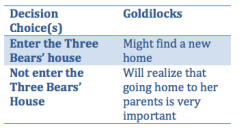Goldilocks has been feeling her oats lately and has also begun to challenge her parents on the kinds of things children typically begin to challenge their parents on since the days of Fred Flintstone. You know– what time to go to bed, what clothes to wear, etc.
While Goldilocks’ parents may have been more enlightened than your average Fairy Tale parents, they nonetheless recognized that they were responsible for her well being and understandably refused to let Goldilocks have her way in all things.
The result is well documented … Goldilocks decided to run away. But how might her decision “look” in a cross impact matrix?
Figure one below, captures the most obvious choices and the possible impacts of those choices.
Figure One
It’s possible, had Goldilocks used this kind of spreadsheet thinking, that we would never have had the Goldilocks story in the first place! Leaders typically are confronted with hundreds of decision occasions a day. Some of these are easy many of them are more difficult.
…
Consider this scenario: Robert is a seventeen year old Special Education student who is in his third high school, a victim to dueling divorced parents, who have changed custody of him twice and who have moved several times. Dealt with clearly, firmly, and with a nurturing tone Robert responds pretty well to his self-contained teachers academically and behaviorally. However in the grander arena of any high school, Robert will have problems with other students and with teachers less inclined to try to reason with him.
A bad/good example is Mr. Smith, a Physical Education teacher whose testosterone and bluster are well known in the high school both among his colleagues and the students. Mr. Smith has taken Robert to your office when Robert refused to dress for gym. As you begin to review the issue with Robert and Mr. Smith, the teacher begins to verbally abuse the student, calling him “Loser”, and “Dummy” among other things.
You tell Mr. Smith to stop. Before he does, Smith notices that Robert is getting very angry and about to explode. Robert begins to curse. Smith rises up and invites Robert to take a swing at him. You step in between the two. You order Robert to sit down and you order Smith to leave the office.
After reviewing all of what has gone on and also waiting for Robert to calm down you call his mother to take him home for the day and tell him that you will deal with the issue on whole the next day. Smith returns to the office an hour later and demands to know why the student has not been suspended out of school for a longer duration.
You know the policy about suspension of special education students and of any student’s suspension for insubordination. You have also witnessed a teacher’s deliberate provocation of a student and know that while the student’s initial refusal to dress for gym requires your action, the ensuing, near physical confrontation is the result of Smith’s behavior.
Figure Two below has a more complex and admittedly incomplete spreadsheet/cross impact matrix projection of the systems/and group issues that may be affected by the result of your decisions.
Figure 2
The message here is that decision-making, short-term, and more importantly long term, is difficult.
The analytical tool offered in the two figures above is not intended for a thoughtful leader’s use for short-term decision occasions. If there is an emergency for example, a principal hasn’t the time to project impacts of given choices!
For longer-term decision occasions, for project initiatives, for changing the vision and direction of a building, for example, such kind of thinking, of what we might call systems thinking, is a critically necessary component. This is especially so when the leader seeks to involve other stakeholders in meaningful strategic planning.
In other words, when seeking to implement and to involve others in the kinds of decision– actions whose sum will change the momentum and influence a new direction of your school organization this is but one of several tools a leader can use to make real differences.
The danger however is that it is very possible that spreadsheet thinking is not or, at best, poorly practiced. It is very possible that the leader, by dint of the onslaught of urgent and not seemingly important decision occasions does not make the time to use spreadsheet thinking for those issues that are important for the new directions a school might require.
In an educational era where leaders must as the Knight of the Holy Grail in Indiana Jones and the Last Crusade said, “Choose and choose wisely”, we had better!
~Richard Bernato, Ed.D.

